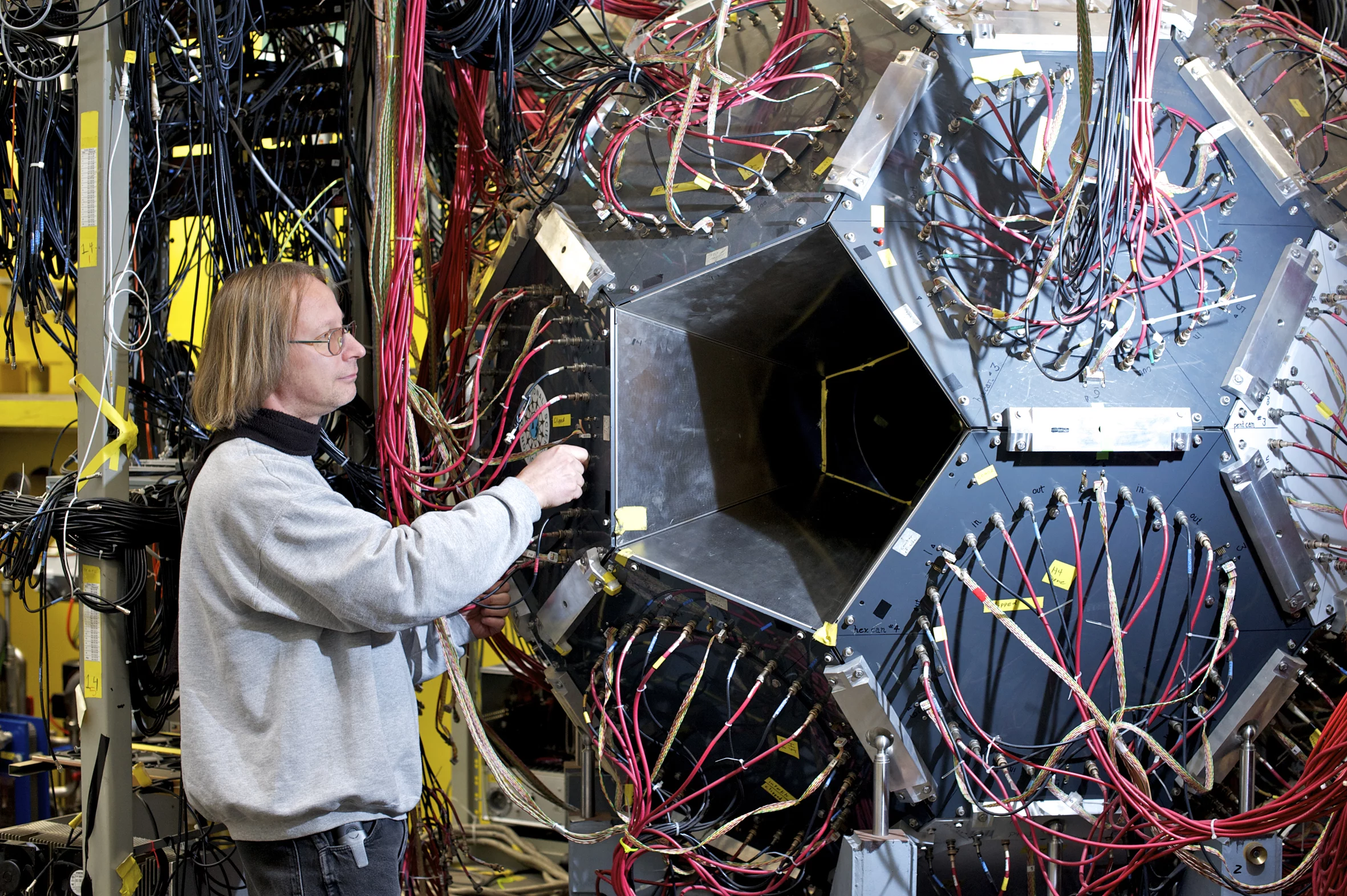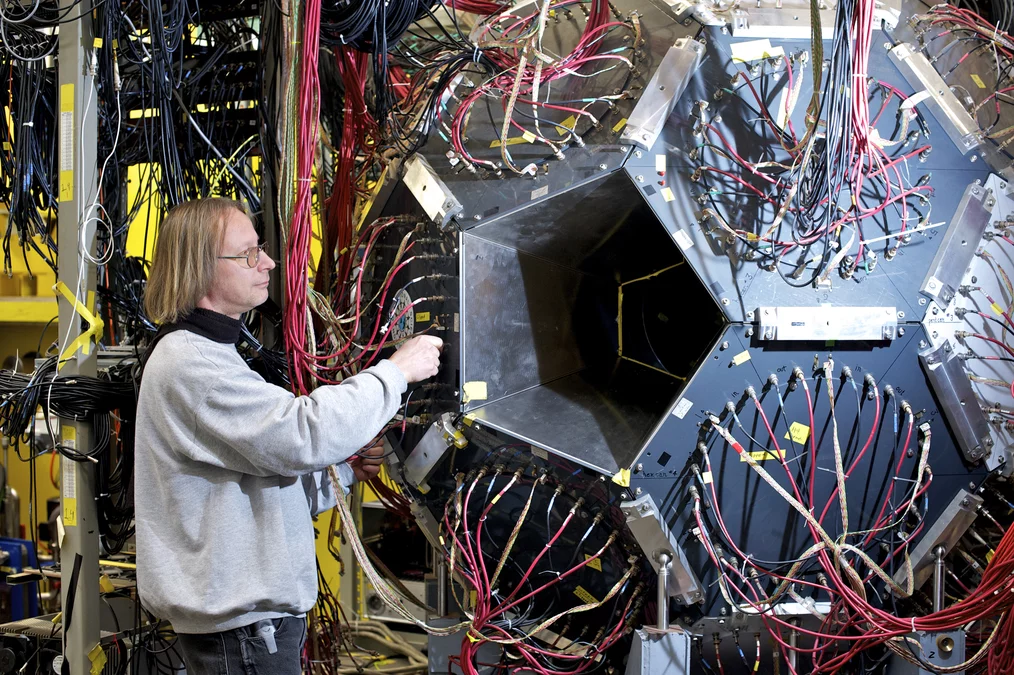New measurement of the muon lifetime – the most precise determination of any lifetime – provides a high-accuracy value for a crucial parameter determining the strength of weak nuclear force. The experiments were performed by an international research team at the accelerator facility of the Paul Scherrer Institute. The results are about to be published in the journal Physical Review Letters.
The weak force is one of the four fundamental forces of Nature. Although we hardly encounter processes governed by the weak force in our everyday life, it is still of crucial importance; e.g., being responsible for the processes that make the Sun shine. An international research team led by scientists from the University of Illinois, Boston University and the University of Kentucky performed experiments at the Paul Scherrer Institute (Villigen, Switzerland) that allowed them to determine a parameter crucial for the strength of the weak force with unprecedented accuracy of 0.6 parts per million. This so called Fermi constant is one of the fundamental natural constants needed for exact calculations of processes in the world of elementary particles.
One of the main breakthroughs in our understanding of the subatomic world in the 1970s was the proof that the weak interaction and the electromagnetic interaction – another of the four fundamental forces – are, in fact, two aspects of one and the same interaction. It is called the electroweak interaction and its strength is determined by three parameters, the Fermi constant being one of them.
Muon lifetime – key to the strength of the weak force
The new value of the Fermi constant has been determined via an extremely precise determination of the lifetime of the muon – the most precise measurement of the lifetime of any state in the atomic and subatomic world. The muon is an unstable subatomic particle decaying with a lifetime of approx. 2 microseconds (millionth of a second). This decay is governed by the weak force only and the muon’s lifetime has a relatively simple relationship to the strength of the weak force. To determine the Fermi constant from the muon lifetime requires elegant and precise theory; but, until 1999 the theory was not as good as the experiments.
says David Hertzog, at the time of the experiment at the University of Illinois, now at the University of Washington Since then several breakthroughs essentially eliminated the theoretical uncertainty. The largest uncertainty in the Fermi constant determination was now based on how well the muon lifetime had been measured.
Measuring procedure repeated 100 billion times – precision of the measurement 2 millionths of a millionth of a second
The MuLan (Muon Lifetime Analysis) experiment used muons produced at the proton accelerator of the Paul Scherrer Institute (Villigen, Switzerland) – the most powerful source of muons in the world and the only place where this kind of experiment can be done. At the heart of the experiment were special targets that caught groups of arriving positively charged muons during a muon fill period.
explains Bernhard Lauss from the Paul Scherrer Institute The beam was then rapidly switched off, leaving approximately 20 muons in the target. Each muon would eventually decay, typically ejecting an energetic positron – a positively charged electron – to indicate its demise. The positrons were detected using a soccer-ball shaped array of 170 detectors, which surrounded the target.
Robert Carey from Boston University adds: We repeated this procedure for 100 billion muon fills, accumulating trillions of individual decays, which in turn required more than 100 TBytes of data to be stored for later analysis using the large supercomputer cluster at National Center for Supercomputing Applications (NCSA) in Illinois.
A distribution of how long each muon lived before it decayed was created from the raw data and fit to determine the mean lifetime, obtaining the value of 2.1969803 ± 0.0000022 microseconds. The uncertainty is approximately 2 millionths of a millionth of a second – a real world record.
The collaboration
The experiments were performed at the Paul Scherrer Institute by an international collaboration including scientists from the following institutions:
- Department of Physics, University of Illinois at Urbana-Champaign, Urbana USA
- Department of Physics and Astronomy, University of Kentucky, Lexington, USA
- Department of Physics, Boston University, Boston, USA
- Department of Physics, James Madison University, Harrisonburg, USA
- Department of Physics and Computational Science, Regis University, Denver, USA
- Department of Mathematics and Physics, Kentucky Wesleyan College, Owensboro, USA
- Paul Scherrer Institute, Villigen PSI, Switzerland
- Kernfysisch Versneller Instituut, University of Groningen, Groningen, The Netherlands
Text: Paul Piwnicki/David Hertzog
About PSI
The Paul Scherrer Institute develops, builds and operates large-scale, complex research facilities, and makes these facilities available to the national and international research community. The Institute's own research focuses on solid-state physics and the materials sciences, elementary particle physics, biology and medicine, as well as research involving energy and the environment. With a workforce of 1400 and an annual budget of about 300 million CHF, PSI is the largest research institution in Switzerland.
Contacts
Prof. David Hertzog, University of Illinois, jetzt an der University of Washington,Department of Physics, Box 351560, Seattle, WA 98195-1560, USA,
Telefon: +1 206 543-0839, E-Mail: hertzog@uw.edu
Prof. Robert Carey, Boston University, Department of Physics,
590 Commonwealth Avenue, Boston, MA 02215, USA,
Telefon: +1 617 353 6031 E-Mail: carey@bu.edu
Dr. Bernhard Lauss, Labor für Teilchenphysik,
Paul Scherrer Institut, 5232 Villigen PSI, Schweiz,
Telefon: +41 56 310 46 47, E-Mail: bernhard.lauss@psi.ch
Original Publication
Measurement of the Positive Muon Lifetime and Determination of the Fermi Constant to Part-per-Million PrecisionD.M.Webber et al. (MuLan Collaboration),
Physical Review Letters DOI: 10.1103/PhysRevLett.106.041803


